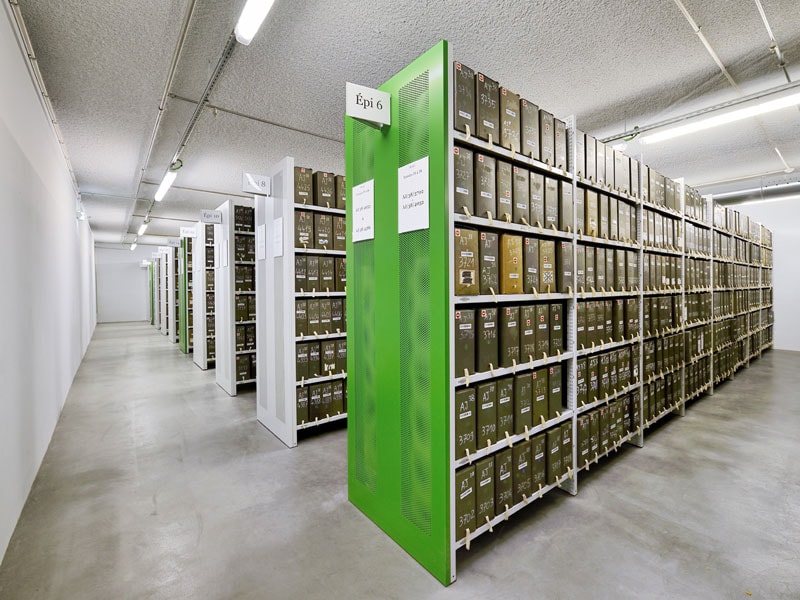Static shelving offers a stable and fixed storage solution for workplaces. It enhances organisation and provides easy manual access to items. Unlike mobile shelves, static shelves remain secure and constant. This article discusses the benefits, features, and types of static shelving to help you optimise your workspace.
Key Takeaways
- Static shelving systems are fixed in place, providing stable and secure storage solutions ideal for environments requiring frequent manual access.
- Static shelving enhances organisation, maximises storage capacity, and increases efficiency by allowing for easy access and categorisation of items.
- Understanding the types of static shelving, such as single-sided and double-sided, is essential for selecting the right solution tailored to specific storage needs.
Understanding Static Shelving Systems

Static shelving systems are designed to remain fixed in place, providing a stable and permanent solution for storing lightweight inventory that requires manual handling. Unlike mobile shelving, which can be moved to create more storage space, static shelves remain in one spot, offering consistent stability and security. This makes them ideal for environments where items need to be accessed frequently and manually.
The primary purpose of static shelving is to optimise storage space and improve organisation. These systems can be adjusted without the need for professional assistance, making the installation process user-friendly.
Knowing the fundamentals and types of static shelving helps in optimising workplace organisation and storage efficiency. Here’s a closer look at what static shelving involves and how it contrasts with other storage solutions.
What is Static Shelving?
Static shelving is characterised by its fixed position, providing stability and permanence for heavy items. This type of shelving system is designed to withstand substantial loads without moving, making it an excellent choice for environments where stability is crucial. Static shelving comes in various types, each designed for specific storage needs and environments.
Grasping the concept and variety of static shelving is crucial for enhancing workplace organisation and storage efficiency. Whether managing office documents or warehouse inventory, static shelves offer a dependable and stable storage solution.
The stability of static shelving sets it apart from other storage systems, ensuring secure and easily accessible storage for your items.
Features of Static Shelves
One of the standout features of static shelves is their robust structural integrity. Constructed from high-grade steel with a durable epoxy powder coating, ensures both strength and aesthetic appeal. This makes them suitable for various environments, from industrial settings to office spaces and libraries.
Another significant feature is the adjustability of the shelves. Static shelving systems allow for shelves to be adjusted in 20 mm increments, facilitating easy changes to the configuration of storage layouts. This adjustability ensures that the shelves can be customised to meet the specific storage needs of different items, whether they are lightweight office supplies or heavy industrial products.
The combination of strength and adjustability in static shelves significantly contributes to efficient and effective storage solutions. These features not only enhance the storage capacity of the shelving system but also ensure that it can be tailored to fit the unique requirements of any workspace. Static shelves, with their durability and customisability, significantly enhance organisation and efficiency in diverse environments.
Difference Between Racking and Shelving
While both racking and shelving systems are essential for storage, they serve different purposes and environments. Static shelving is distinct from racking as it is not designed for forklift use, focusing instead on manual inventory management. This makes static shelving ideal for settings like offices and libraries where manual handling of items is prevalent.
In contrast, racking systems are beneficial for warehouses and distribution centres that require quick access and efficient use of space through mechanical assistance. Racking allows for the high-density storage of items that can be moved using forklifts, making it suitable for environments where mechanical handling is necessary.
Knowing the difference between racking and shelving aids in selecting the appropriate storage solution tailored to your workplace needs.
Dimensions and capacity

Static shelving systems are effective solutions for optimising floor space in various settings, including offices and industrial environments. There are several types of static shelving, each designed to meet different storage needs and preferences.
Here are the standard dimensions and capacities:
Dimensions
Height:
1632mm, 1832mm, 1952mm, 2032mm, 2112mm, 2232mm, 2312mm, 2592mm and 2952mm
Depth:
250, 300, 400, 450, 500, 600, 700, and 800mm
Bay Width:
900, 1000, 1100 and 1200mm
Shelf:
32mm in height
triple-folded longitudinal edges, height adjustment 20m increments
Capacity
Bay capacity
Depending on upright frame type max 2000kg
Shelf Capacity
Bay width 900mm: Max 130kg
Bay width 1000mm: Max 120kg
Bay width 1100mm: Max 110kg
Bay width 1200mm: Max 100kg
Benefits of Static Shelving in the Workplace

Static shelving provides structured storage solutions that enhance organisation and efficiency in various sectors. By offering designated storage spaces, static shelving systems facilitate faster and more efficient retrieval of materials. These systems are primarily used for storing items that need frequent manual picking and organisation.
The benefits of static shelving extend beyond just organisation. They also enhance storage capacity, allowing businesses to maximise available storage areas. Accessories can significantly improve the functionality and versatility of static shelving systems, making them more adaptable to various needs.
Here are the specific benefits: improved organisation, enhanced storage capacity, and increased efficiency.
Improved Organisation
Static shelving provides designated storage spaces, facilitating faster and more efficient retrieval of materials. Categorising items with static shelving systems simplifies locating specific materials, thus improving access and retrieval times. This streamlines workflows reduces operational delays from disorganised storage and enhances productivity.
Enhanced Storage Capacity
Static shelving maximises available floor space by enabling high-density vertical storage. Conventional static shelving allows businesses to utilise higher storage, optimising vertical space without expanding the floor area. This is particularly beneficial in warehouses, where static shelving enhances overall storage efficiency by facilitating high-density stacking and allowing for easy access to inventory.
Increased Efficiency
By providing a systematic organisation of materials, static shelving makes retrieval easier and reduces clutter. An optimised storage solution through static shelving reduces wasted space, streamlining operations and enhancing productivity.
This increased efficiency in workflows allows for quicker access to materials and a more organised workplace.
Adjustability
Shelves can easily be adjusted to different heights, allowing for flexible storage of items of different shapes and sizes.
An abundance of accessories are available and can be retro fitted
Key Considerations for Choosing Static Shelving

When selecting static shelving, it’s crucial to understand your specific storage needs, including the types and sizes of items being stored. Proper installation and maintenance of static shelving is essential for ensuring safety and longevity.
Let’s explore the key considerations for choosing the right static shelving, focusing on load capacity, space and dimensions, and material and durability.
Space and Dimensions
Measure from wall to wall and floor to ceiling, considering slanted roofs. Assess any obstructions in the warehouse that might impact shelving placement and layout planning. Ensure the floor is level and sound before installing shelving to maintain stability.
Follow the manufacturer’s specific installation instructions to prevent structural failures.
With a huge availability of sizes and configurations, static shelving can be tailed to meet clients specific storage needs.
Material and Durability
The right shelving material greatly affects its durability and maintenance needs. For instance, galvanised steel shelving offers excellent strength and corrosion resistance, ensuring stability and longevity in various environments.
Installation and Maintenance of Static Shelving
Proper installation of static shelving is crucial for ensuring its durability and safety. Using special safety equipment, like ladders, when reaching higher shelves can avoid accidents.
Installation Tips
Adhering to manufacturer instructions and using proper tools can prevent structural issues and ensure secure installation of the shelving system.
Maintenance Practices
Routine maintenance, like cleaning to prevent dust accumulation, is vital for keeping the shelving system in optimal condition. Keep aisles clear of obstructions to promote safety and facilitate easy access.
Storing heavier items on lower shelves minimises the risk of falls and injuries.
Applications of Static Shelving

Static shelving can be efficiently utilised in various environments, including offices, store rooms, and warehouses. These systems help optimise storage space and streamline inventory management in different settings.
Here are some specific applications of static shelving in warehouses, offices, and libraries.
Libraries
Static shelving in libraries supports systematic arrangement, facilitating quick and easy access to books and resources. This type of shelving enables systematic categorisation of books, making it simpler for patrons to locate and access materials quickly.
The durability and organisation offered by static shelving make it an ideal choice for library settings.
Warehouses
Static shelving in warehouses enhances inventory management by offering a systematic layout for easy access to goods. This type of shelving is often utilised for storing smaller items, which streamlines the pick-and-pack process by allowing easy access.
Static shelving plays a crucial role in optimising storage space by allowing for better organisation and utilisation of the warehouse layout.
Offices
In offices, static shelving offers a flexible and customisable solution for varying document and supply needs. Using static shelving improves workspace management by maximising efficiency and reducing clutter.
This investment is crucial for maintaining an organised office, ultimately supporting a more productive work atmosphere.
Enhancing Static Shelving with Accessories
Accessories for static shelving are essential as they enhance functionality and versatility, allowing users to customise their systems to better fit their needs. These accessories can significantly improve the organisation and storage capacity of static shelving systems, making them more adaptable to various needs.
Here are some of the most useful accessories: cladding options, additional shelves and dividers, and security features.
Decorative Options
At client’s request, shelving can be furnished with individualised end panels. Whether perforated or plain steel, timber of glass, designs can be optimally matched to the surrounding architecture.
Create your very own environment with digital printing, allows you to select custom designs.
Perforated end panels and frames have the added bonus of improving air flow through the stored goods.
Additional Shelves and Dividers
Adding extra shelves and dividers to your shelving system allows for better organisation and maximised storage efficiency. These customisation options ensure that items of various sizes and types can be stored neatly and accessed easily.
Shelf dividers come in multiple widths to accommodate different shelving configurations, further enhancing organisation. Ultimately, adding shelves and dividers optimises space and enhances storage system efficiency.
There is an abundance of choice for booksupports to keep your books upright and straight. Sliding and angular booksupports are available in various heights and widths. Side stops which hold in place books stored in open frames, can easily be height-adjusted and do not restrict air flow.
Magazine Displays
Panels displaying journals at various angles offer an excellent view, showing them off at their best. The shelves can be fitted to every frame height, reflecting individuality and professionality throughout.
Security Features
Incorporating features like lockable doors enhances the security of static shelving, protecting valuable items from theft or unauthorised access. Lockable doors and drawers are essential for safeguarding high-value inventory or sensitive materials. By integrating lockable doors into shelving units, you ensure that sensitive or high-value items are kept secure from unauthorised access.
These security features add an extra layer of protection, making static shelving systems suitable for storing a wide range of valuable items.
Summary
Static shelving systems offer a reliable and efficient solution for enhancing organisation and storage capacity in various environments. From understanding what static shelving is and its distinct features to exploring different types and their specific applications, we have seen how these systems can transform workplaces. The benefits of static shelving—improved organisation, enhanced storage capacity, and increased efficiency—are clear and significant.
When choosing static shelving, it is essential to consider factors like load capacity, space and dimensions, and material durability. Proper installation and regular maintenance are crucial for ensuring the longevity and safety of these systems. Additionally, accessories such as cladding options, extra shelves, dividers, and security features can further enhance the functionality and customisability of static shelving. By incorporating static shelving into your workplace, you can achieve a more organised, efficient, and productive environment.
Frequently Asked Questions
Static shelving provides a stable and permanent solution for storing heavy items, optimising space, and enhancing organisation in various settings. Its fixed position ensures reliability and efficiency in storage management.
Static shelves are characterised by their robust structural integrity, adjustability in 20 mm increments, and high load-bearing capacity, making them both durable and versatile for various storage requirements.
Static shelving is primarily used for manual inventory management in spaces like offices, while racking systems are designed for mechanical handling and high-density storage in warehouses. This distinction makes each suitable for different environments and inventory needs.
Using static shelving in the workplace significantly enhances organisation and boosts storage capacity, leading to increased efficiency through quicker material retrieval and reduced clutter. This structured approach not only optimises space but also streamlines workflow.
When choosing static shelving, prioritise load capacity, space dimensions, and material durability. Proper installation and maintenance practices are vital for safety and longevity.
Recent Comments